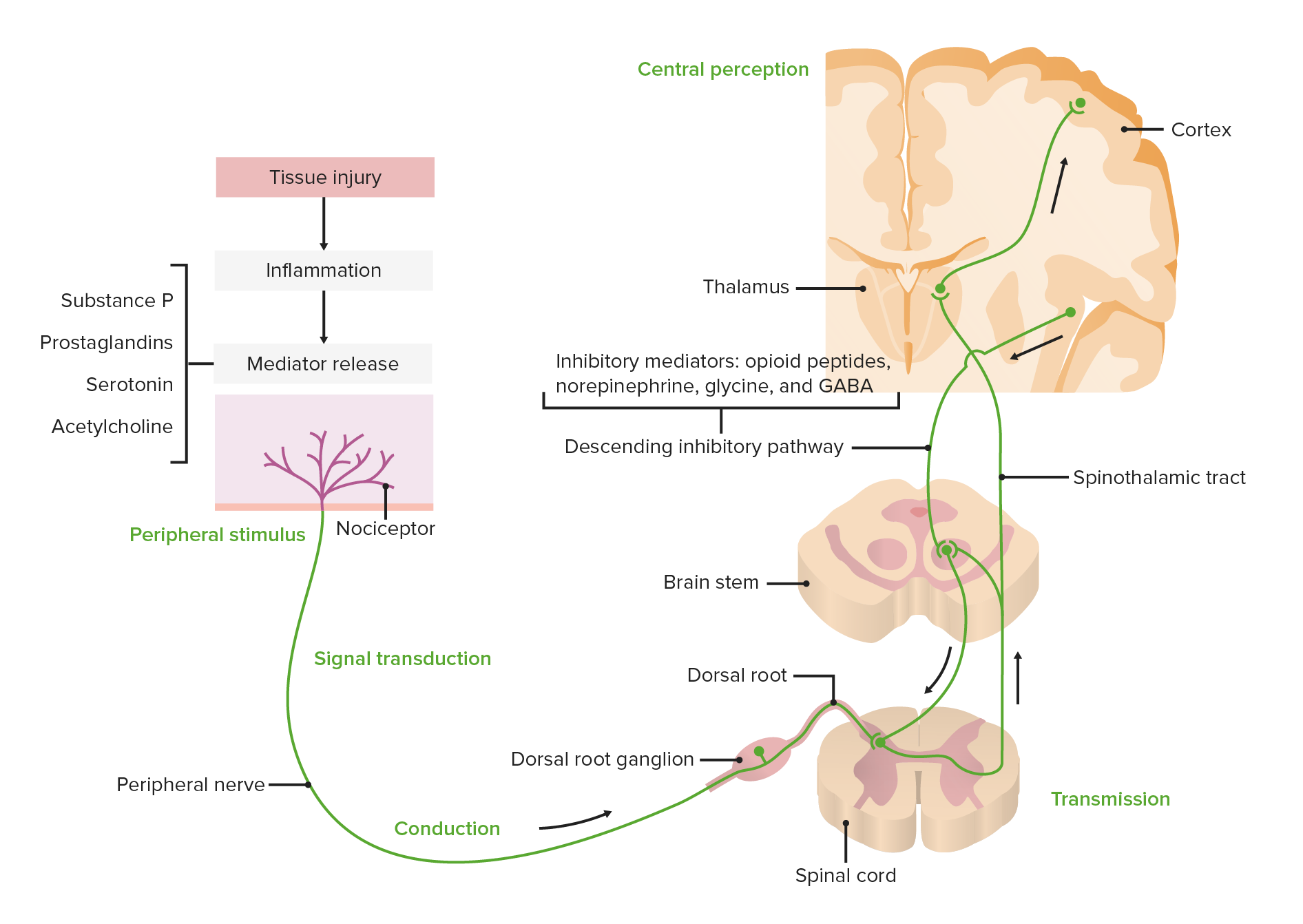Playlist
Show Playlist
Hide Playlist
Neuropathic Pain: Understanding Reflex Arcs
-
Slides Neuropathic Pain Syndromes.pdf
-
Download Lecture Overview
00:01 Now, let's talk a little bit about how the body feels pain. 00:04 Pain is perceived in both the central and peripheral nervous systems. 00:08 And so we're going to talk about central nervous system control of neuropathic pain and peripheral nervous system control of pain. 00:15 In the peripheral nervous system, we know that the nerves start as the nerve roots and then, extend into the plexus, and then end in the terminal nerve branches. 00:24 And dysfunction in any of these areas can contribute to the development of neuropathic pain. 00:30 So let's take a closer look at how the body feels pain. 00:33 Well, first, a sensory nerve feels pain in the skin. 00:37 That may be pain or a temperature response, or vibration, or some painful sensation in the skin. 00:43 This is carried by an action potential in sensory neurons towards and to the spinal cord. 00:50 Those peripheral sensory neurons, cell bodies are contained within the dorsal root ganglia. 00:56 That sensory information is relayed into the spinal cord and there's already some modulation of that signal as a result of interneurons within the spinal cord. 01:05 But ultimately, the signal is propagated towards the brain through the white matter tracts in the spinal cord. 01:12 Sensory pathways continue to second order neurons projecting into the thalamus. 01:17 And the thalamus is really the primary mediator and regulator of all sensory input to the brain. 01:26 Sensory information ultimately reaches the cerebral cortex, and that's where sensory pathways reach the brain for conscious perception of pain. 01:33 The brain doesn't feel pain, but it is the part of the body that perceives pain, that understands what it is. Is this a good pain or a bad pain? Do I need to recoil or keep doing this? In the circumstance of a hand feeling hot water, we want the hand to recoil away. 01:49 So that sensory stimulus that's perceived in the brain will generate a motor response. 01:56 Motor responses start in the primary motor cortex and descend as any volitional motor action through the internal capsule to the brain stem, down the spinal cord where there's a synapse in the ventral horn. 02:08 That information travels out the peripheral motor neuron and motor nerve to the hand and the hand recoils. 02:16 In addition to central nervous system control and perception of pain, the spinal cord is also important. There are a number of spinal reflexes that allow the body to move away from a painful stimulus without even thinking about it. 02:32 And you can think about what happens if you were to step on a nail. 02:35 Before you even know that it's a nail or that you even feel pain, your foot is moving away from the nail and moving away from that painful stimulus. 02:45 And what does this is a spinal reflex. You can see what's happening here. 02:48 First, the painful sensory response is felt in the skin in the foot. 02:53 That information is travelled quickly into the spinal cord where it will travel up to the brain. 02:59 And ultimately, the brain will realize that I'm stepping on a nail. 03:02 But before that happens, that signal is transferred through interneurons in the spinal cord to the ventral horn. 03:08 And there's an activation of motor neurons that move the leg up, that contract the quad, that relax the muscles of the - of knee flexion and move the leg away from the painful stimulus. 03:23 So both central nervous system and spinal reflex control of pain are important in the body's safety mechanisms.
About the Lecture
The lecture Neuropathic Pain: Understanding Reflex Arcs by Roy Strowd, MD is from the course Neuropathic Pain Syndromes.
Included Quiz Questions
What is the pathway of pain sensation in the body?
- External stimulus → peripheral sensory neurons → spinal cord → second-order neurons → thalamus
- External stimulus → thalamus → second-order neurons → spinal cord → peripheral sensory neurons
- External stimulus → dorsal nerve roots → spinal cord → second-order neurons → third-order neurons --> brainstem
- External stimulus → peripheral nerve roots → spinal cord → second-order neurons → brainstem
- External stimulus → lower motor neuron → spinal cord → cerebral cortex → upper motor neuron
What is the pathway of the spinal reflex arc?
- External stimulus → peripheral sensory nerve fibers → interneurons in spinal cord → peripheral motor nerve fibers
- External stimulus → dorsal column → ventral column → peripheral motor nerve fibers
- External stimulus → peripheral sensory neurons → spinal cord → thalamus → spinal cord → peripheral motor nerves
- External stimulus → spinal cord → motor cortex → spinal cord → peripheral motor nerve fibers
- External stimulus → peripheral motor nerve fibers → spinal cord → cerebral cortex → peripheral sensory nerve fibers
Customer reviews
5,0 of 5 stars
| 5 Stars |
|
5 |
| 4 Stars |
|
0 |
| 3 Stars |
|
0 |
| 2 Stars |
|
0 |
| 1 Star |
|
0 |




